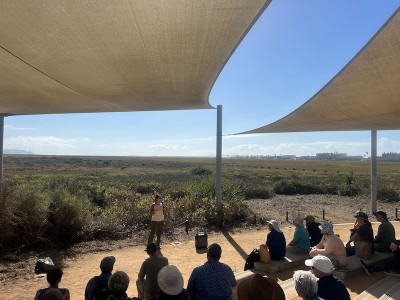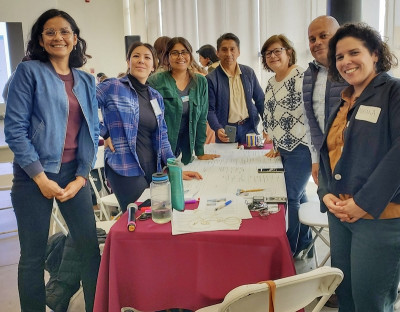If there is one thing Meliza Le Alvarado has learned during the first year of her pioneering Binational Climate Fellowship, it’s this: Forging cross-national partnerships to strengthen coastal resilience is not something that happens from behind the computer.
“The people on the front lines are out there doing things,” says Le Alvarado.
As the first-ever Binational Climate Fellow, a position co-funded by California Sea Grant and the Climate Science Alliance, Le Alvarado has found herself traveling back and forth between the San Diego and Northern Baja California, Mexico, regions since taking the role in January 2023. On both sides of the border, she has sought out events and initiatives that allowed her to connect with Indigenous communities, scientists and other stakeholders throughout coastal Northern Mexico and Southern California.
“It's not the traditional way of doing things."
Le Alvarado attended the San Diego Climate Summit, where over 200 people met for a day of storytelling and knowledge-sharing. She went diving with an ecology group in Ensenada, Baja California, and helped

remove over 22,000 sea urchins to support kelp forest restoration. She led young participants of the First Youth Indigenous Camp at Sierra Juárez on a climate-education scavenger hunt. She took part in a San Diego estuaries research symposium, a binational nature-based solutions workshop held by TRNERR, a coastal sage scrub restoration and many other events. In the process, Le Alvarado formally interviewed 64 stakeholders on both sides of the border while forming personal connections with scores more.
“It's not the traditional way of doing things. As a biologist, I'm more used to the scientific method and research,” says Le Alvarado. “But when you’re trying to build meaningful relationships, it's more about being a mediator, about being the person who carries ideas to different groups.”
A connected coastal landscape
San Diego County and Northern Baja California share a connected coastal landscape that supports the livelihoods and cultures of millions of people. The area faces mounting threats from climate change and extreme weather events that pose risks to both communities and ecosystems. To tackle these challenges, numerous groups are actively exploring strategies to bolster coastal resilience. As the Binational Climate Extension Fellow, Le Alvarado focuses on climate and ecological challenges that cross the border and tries to bring together Indigenous communities, activists and scientists from both countries.
“It might sound easy to just talk to people and share knowledge but it’s often a challenge,” she says. “It's like knocking on doors and trying to catch opportunities to connect and just hanging in there.”
Le Alvarado grew up in Ensenada, Mexico, and earned a bachelor’s degree in biology from the Autonomous University of Baja California, followed by a master’s degree in marine ecology from the Centro de Investigación Científica y de Educación Superior de Ensenada. Before starting the Fellowship, Le Alvarado worked with the federal Mexican government and local fishermen to conduct monitoring of commercial species such as clams and lobsters and conduct kelp forest surveys of sea urchins. Her current fellowship is supported with funding from the Binational Resilience Initiative, a partnership between the San Diego Foundation and the International Community Foundation.
Differences mean that both sides can profit
Le Alvarado has noticed that coastal resilience is often handled differently in California and Baja California. “Even though they are so close to each other, things work very contrastingly,” she says.

For example, funding constraints mean that there are fewer long-term environmental monitoring and coastal resilience initiatives on the Mexican side of the border. On the other hand, the coast in that region is also less developed.
These differences mean that both regions can benefit from collaborating. “On the Mexican side, we can learn from the long history of restoration in California. But for California’s restoration work, it can be useful to look at the original form such as Baja California’s still-pristine dunes. We can learn from each other’s perspective and challenges as a region or country.”
During the second and final year of her fellowship, Alvarado Le hopes to identify and address gaps that might prevent partner organizations in the region from building their resilience. “For example, if there's a need for a workshop for the grading for grants, we can look for a facilitator and the right strategies,” she says.
All of the relationship building, she’s found, can play a key role in filling those gaps.
“One partner organization in Baja received a grant to do coastal dune restoration, they were biologists with lots of knowledge about inland ecological restoration and less experience in coastal processes,” Le Alvarado recalls. “During one of our webinars, a researcher dedicated to coastal processes was listening in and said, ‘We can help you with that’ and that turned out to be incredibly useful.
“Finding each other is a huge step. Once you have done that, lots of things become possible.”
About California Sea Grant
NOAA’s California Sea Grant College Program funds marine research, education and outreach throughout California. Headquartered at Scripps Institution of Oceanography at the University of California San Diego, California Sea Grant is one of 34 Sea Grant programs in the National Oceanic and Atmospheric Administration (NOAA), U.S. Department of Commerce.